

THE SEMIOTICS OF THE WEB. Semiotics of the web interface: analysis and guidelines. Www.seco.tkk.fi/events/2004/2004-09-02-web-intelligence/papers/seppanen_wis04.pdf. SEO tips for web designers – Part 5: keeping it up. This post is part of a serie on SEO for web designers, make sure you don’t miss any update by subscribing to the RSS feed.
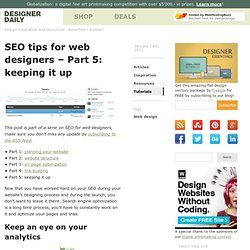
Now that you have worked hard on your SEO during your website’s designing process and during the launch, you don’t want to leave it there. Search engine optimization is a long time process, you’ll have to constantly work on it and optimize your pages and links. Keep an eye on your analytics Once your website is live, you should detect its strengths and weaknesses to know which actions to take. Keep an eye on keywords that bring you traffic and check out the links that bring traffic to the popular pages containing these keywords. You should also be aware of which websites refer to yours. Check your rankings If you are targetting some keywords, check out where they are ranking in Google search results.
You can also check your page rank. SEO Guide for Designers. According to a poll I conducted, just over 1 out of 10 people don't think SEO (Search Engine Optimization) is mandatory as a designer; and what really surprised me is about 24% don't even know what SEO is!

If you’re among the quarter of people who don’t know what SEO is or understand how it can help you, you should really read this article. This is an SEO guide for designers who want to learn about making it easier for websites or blogs to be found by search engines. I'll explain the common mistakes made by designers and developers. Web Typography: Educational Resources, Tools and Techniques - Smashing Magazine. Web typography has evolved a lot over the last years.
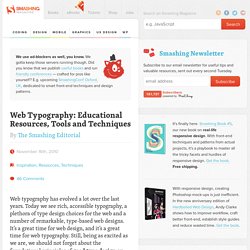
Today we see rich, accessible typography, a plethora of type design choices for the web and a number of remarkable, type-based web designs. It’s a great time for web design, and it’s a great time for web typography. Still, being as excited as we are, we should not forget about the foundational principles of good type design on the web and use them properly within our projects. Great choice is good, but, most importantly, we should be making meaningful typographic choices in our designs.
In this post we present an extensive overview of educational resources, tools, articles, techniques and showcases all related to web typography. We believe that such round-ups are valuable because they present many useful pointers in one place. Business Objectives vs. User Experience - Smashing Magazine. Advertisement Here’s a question for you: would you agree that creating a great user experience should be the primary aim of any Web designer?
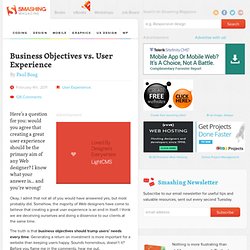
I know what your answer is… and youʼre wrong! Okay, I admit that not all of you would have answered yes, but most probably did. Somehow, the majority of Web designers have come to believe that creating a great user experience is an end in itself. I think we are deceiving ourselves and doing a disservice to our clients at the same time. The truth is that business objectives should trump users’ needs every time. The Harsh Reality Letʼs begin with the harsh truth.
Despite what we might think, our primary aim is to fulfill the business objectives set out by our clients. Is the business world at odds with creativity? Dos and Don'ts of Website Design. Deal mania on GraphicMania!

Check out our deals section for graphic designers and developers. The newest deal can be seen below! Value: €150 | Now: €15 | Discount: 90% CNN’s New Website Design Deconstructed. On Monday, October 26, CNN.com introduced a new website design, making a number of major changes to their information-heavy layout.
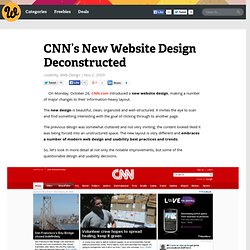
The new design is beautiful, clean, organized and well-structured. It invites the eye to scan and find something interesting with the goal of clicking through to another page. The previous design was somewhat cluttered and not very inviting; the content looked liked it was being forced into an unstructured space.
Eight Ways to Combine Typefaces. Good typography is paramount to any good design.

An otherwise-beautiful design can really suffer if the typography choices are wrong. But combining fonts beyond the basic serif/sans-serif pairing can be tricky and confusing to a lot of designers. While a lot of what goes into good typography is subjective, there are some guidelines that can point you in the right direction. From there, it’s up to you to experiment and try out different things. Don’t be afraid to try new things in your typography, but trust your eye and your instincts as a designer. Match the Mood. Working with Visual Weight in Your Designs. In design, visual weight is the notion that design elements have varied weights; that is, some objects, even on a two-dimensional medium, can appear to be heavier than others.
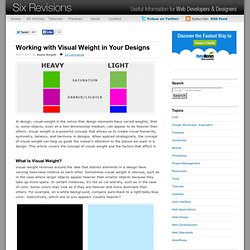
Visual weight is a powerful concept that allows us to create visual hierarchy, symmetry, balance, and harmony in designs. When applied strategically, the concept of visual weight can help us guide the viewer’s attention to the places we want in a design. This article covers the concept of visual weight and the factors that affect it. How to Measure the Effectiveness of Web Designs. At the end of the day, the quality of a web design can only really be measured quantitatively in the results it brings a site.
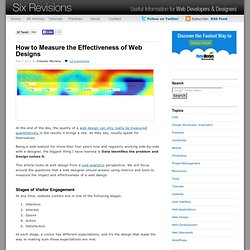
As they say, results speak for themselves. Being a web analyst for more than four years now and regularly working side-by-side with a designer, the biggest thing I have learned is Data identifies the problem and Design solves it. This article looks at web design from a web analytics perspective. We will focus around the questions that a web designer should answer using metrics and tools to measure the impact and effectiveness of a web design. Stages of Visitor Engagement At any time, website visitors are in one of the following stages: AttentionInterestDesireActionSatisfaction At each stage, a visitor has different expectations, and it’s the design that leads the way to making sure those expectations are met. Designing for Grabbing Visitor Attention Questions to ask: Does the design grab the attention of your visitors in just a few seconds? Conclusion Related Content. Web 3.0.